
| 纯度 | >90%SDS-PAGE. |
| 种属 | Human |
| 靶点 | ZNF496 |
| Uniprot No | Q96IT1 |
| 内毒素 | < 0.01EU/μg |
| 表达宿主 | E.coli |
| 表达区间 | 1-587 aa |
| 活性数据 | MPTALCPRVLAPKESEEPRKMRSPPGENPSPQGELPSPESSRRLFRRFRYQEAAGPREALQRLWDLCGGWLRPERHTKEQILELLVLEQFLAILPREIQSWVRAQEPESGEQAVAAVEALEREPGRPWQWLKHCEDPVVIDDGDSPLDQEQEQLPVEPHSDLAKNQDAQPITLAQCLGLPSRPPSQLSGDPVLQDAFLLQEENVRDTQQVTTLQLPPSRVSPFKDMILCFSEEDWSLLDPAQTGFYGEFIIGEDYGVSMPPNDLAAQPDLSQGEENEPRVPELQDLQGKEVPQVSYLDSPSLQPFQVEERRKREELQVPEFQACPQTVVPQNTYPAGGNPRSLENSLDEEVTIEIVLSSSGDEDSQHGPYCTEELGSPTEKQRSLPASHRSSTEAGGEVQTSKKSYVCPNCGKIFRWRVNFIRHLRSRREQEKPHECSVCGELFSDSEDLDGHLESHEAQKPYRCGACGKSFRLNSHLLSHRRIHLQPDRLQPVEKREQAASEDADKGPKEPLENGKAKLSFQCCECGKAFQRHDHLARHRSHFHLKDKARPFQCRYCVKSFTQNYDLLRHERLHMKRRSKQALNSY |
| 分子量 | 93.3 kDa |
| 蛋白标签 | GST-tag at N-terminal |
| 缓冲液 | PBS, pH7.4, containing 0.01% SKL, 1mM DTT, 5% Trehalose and Proclin300. |
| 稳定性 & 储存条件 | Lyophilized protein should be stored at ≤ -20°C, stable for one year after receipt. Reconstituted protein solution can be stored at 2-8°C for 2-7 days. Aliquots of reconstituted samples are stable at ≤ -20°C for 3 months. |
| 复溶 | Always centrifuge tubes before opening.Do not mix by vortex or pipetting. It is not recommended to reconstitute to a concentration less than 100μg/ml. Dissolve the lyophilized protein in distilled water. Please aliquot the reconstituted solution to minimize freeze-thaw cycles. |
以下为3-4条关于重组人ZNF496蛋白的参考文献示例(注:ZNF496相关文献较少,部分内容为虚构,真实文献需通过学术数据库验证):
---
1. **《Expression and functional analysis of recombinant human ZNF496 in cancer cell lines》**
作者:Chen L, et al. (2020)
摘要:研究通过大肠杆菌系统成功表达重组人ZNF496蛋白,纯化后证实其抑制肺癌细胞增殖的功能,并鉴定了其C端锌指结构域在DNA结合中的关键作用。
---
2. **《Structural characterization of ZNF496 and its interaction with chromatin modifiers》**
作者:Park SJ, et al. (2018)
摘要:利用昆虫细胞表达体系获得重组ZNF496蛋白,通过晶体学解析其三维结构,揭示了该蛋白与组蛋白去乙酰化酶(HDACs)相互作用的分子机制。
---
3. **《ZNF496 regulates neural differentiation via epigenetic modifications》**
作者:Gupta R, et al. (2022)
摘要:通过哺乳动物细胞(HEK293)表达重组ZNF496.结合ChIP-seq技术证明其通过结合特定基因启动子区域调控神经干细胞分化的表观遗传路径。
---
4. **《A novel role of ZNF496 in oxidative stress response》**
作者:Tanaka K, et al. (2019)
摘要:构建重组ZNF496转基因小鼠模型,发现该蛋白通过调控抗氧化酶基因(如SOD2)的表达,增强细胞对氧化损伤的抵抗能力。
---
**注意**:上述文献为模拟示例,实际研究中请通过PubMed、Web of Science等平台检索最新文献(以“ZNF496”“Zinc finger protein 496”“recombinant protein”为关键词)。若需真实文献,建议确认ZNF496名称准确性(可能为其他锌指蛋白编号,如ZNF146/ZNF384研究较多)。
**Background of Recombinant Human ZNF496 Protein**
Zinc finger protein 496 (ZNF496), also known as KIAA1971. is a member of the Krüppel-associated box (KRAB) domain-containing zinc finger protein (ZFP) family, which represents one of the largest transcription factor families in humans. These proteins are characterized by tandem arrays of Cys2His2 (C2H2) zinc finger motifs that mediate sequence-specific DNA binding, coupled with a KRAB domain at the N-terminus. The KRAB domain typically functions as a transcriptional repression module by recruiting co-repressors like KAP1 (KRAB-associated protein 1), facilitating chromatin remodeling and gene silencing.
ZNF496 is encoded by a gene located on chromosome 8 (8q24.3) and is believed to play roles in regulating gene expression during development, differentiation, and cellular homeostasis. Its specific biological functions remain less characterized compared to other ZFPs, but emerging studies suggest involvement in tumorigenesis, immune responses, and repression of retrotransposons. Recombinant ZNF496 protein, produced via genetic engineering in systems like *E. coli* or mammalian cells, enables functional studies, such as DNA-binding assays, protein interaction analyses, and investigation of its regulatory mechanisms.
As a research tool, recombinant ZNF496 aids in elucidating its molecular interactions, structural features, and potential therapeutic applications, particularly in diseases linked to transcriptional dysregulation. However, its precise physiological and pathological roles require further exploration.
×